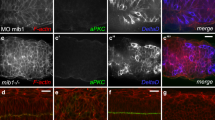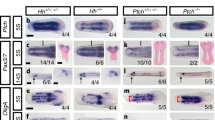Abstract
In the vertebrate central nervous system (CNS), a cascade of signals that originates in the ectoderm adjacent to the neural tube is propagated by the roof plate to dorsalize the neural tube1. Here we report that the phenotype of the spontaneous neurological mutant mouse dreher ( dr)2,3,4,5 results from a failure of the roof plate to develop. Dorsalization of the neural tube is consequently affected: dorsal interneurons in the spinal cord and granule neurons in the cerebellar cortex are lost, and the dorsal vertebral neural arches fail to form. Positional cloning of dreher indicates that the LIM homeodomain protein, Lmx1a, is affected in three different alleles of dreher. Lmx1a is expressed in the roof plate along the neuraxis during development of the CNS. Thus, Lmx1a is required for development of the roof plate and, in turn, for specification of dorsal cell fates in the CNS and developing vertebrae.
This is a preview of subscription content, access via your institution
Access options
Subscribe to this journal
Receive 51 print issues and online access
$199.00 per year
only $3.90 per issue
Buy this article
- Purchase on Springer Link
- Instant access to full article PDF
Prices may be subject to local taxes which are calculated during checkout






Similar content being viewed by others
References
Lee, K. & Jessell, T. The specification of dorsal cell fates in the vertebrate central nervous system. Annu. Rev. Neurosci. 22, 261–294 ( 1999).
Lyons, M., Rastan, S. & Brown, S. Genetic Variants of the Laboratory Mouse 195 (Oxford Univ. Press, Oxford, 1996).
Bergstrom, D., Gagnon, L. & Eicher, E. Genetic and physical mapping of the dreher locus on mouse chromosome 1. Genomics 59, 291– 299 (1999).
Sekiguchi, M., Shimai, K., Guo, H. & Nowakowski, R. Cytoarchitectonic abnormalities in hippocampal formation and cerebellum of dreher mutant. Brain Res. Dev. Brain Res. 67, 105– 112 (1992).
Sekiguchi, M. et al. Disruption of neuronal migration in the neocortex of the dreher mutant mouse. Brain Res. Dev. Brain Res. 77, 37–43 (1994).
Sidman, R. in Genetics of Neurological and Psychiatric Disorders (eds Kety, S., Rowland, L., Sidman,R. & Matthysse, S.) 19–46 (Raven, New York, 1983).
Almasan, A., Mangelsdorf, D., Ong, E., Wahl, G. & Evans, R. Chromosomal location of the human retinoid X receptors. Genomics 20, 397–403 ( 1994).
Walsten, D., Lyons, J. & Zagaja. Shaker short-tail, a spontaneous neurological mutant in the mouse. J. Hered. 74, 421–425 (1983).
German, M., Wang, J., Chadwick, R. & Rutter, W. Synergistic activation of the insulin gene by a LIM-homeo domain protein and a basic helix-loop-helix protein: building a functional insulin minienhancer complex. Genes Dev. 6, 2165–2176 ( 1992).
Schmeichel, K. & Beckerle, M. The LIM domain is a modular protein-binding interface. Cell 79, 211– 219 (1994).
Perez-Alvarado, G. et al. Structure of the carboxy-terminal LIM domain from the cysteine rich protein CRP. Nature Struct. Biol. 1, 388–398 (1994).
Perez-Alvarado, G. et al. Structure of the cysteine-rich intestinal protein, CRIP. J. Mol. Biol. 257, 153–174 (1996).
Konrat, R., Weiskitchen, R., Krautler, B. & Bister, K. Solution structure of the carboxy-terminal LIM domain from quail cysteine-rich protein CRP2. J. Biol. Chem. 272, 12001– 12007 (1997).
Johnson, J. et al. Transcriptional synergy between LIM-Homeodomain proteins and basic helix-loop-helix proteins: the LIM2 domain determines specificity. Mol. Cell Biol. 17, 3488–3496 (1997).
Cordes, S. & Barsh, G. The mouse segmentation gene kr encodes a nocel basic domain-leucine zipper transcription factor. Cell 79, 1025–1034 ( 1994).
Kataoka, K., Noda, M. & Nishizawa, M. Maf nucelar protein recognizes sequences related to an AP-1 site and forms heterodimers with both Fos and Jun. Mol. Cell Biol. 14, 700–712 ( 1994).
Liem, K., Tremml, G. & Hatten, M. The role of roof plate and its resident TGFB-related proteins in neuronal patterning in the dorsal spinal cord. Cell 91, 127–138 (1997).
Ben-Arie, N. et al. Math1 is essential for genesis of cerebellar granule neurons. Nature 390, 169–172 (1997).
Liem, K. F. Jr, Tremml, G., Roelink, H. & Jessell, T. M. Dorsal differentiation of neural plate cells induced by BMP-mediated signals from epidermal ectoderm. Cell 82, 969–979 (1995).
Alder, J., Cho, N. & Hatten, M. Embryonic precursor cells from the rhombic lip are specified to a cerebellar granule neuron identity. Neuron 17, 389– 399 (1996).
Alder, J., Lee, K. J., Jessell, T. M. & Hatten, M. E. Generation of cerebellar granule neurons in vivo by transplantation of BMP-treated neural progenitor cells. Nature Neurosci. 2, 535–540 (1999).
Millonig, J., Millen, K. & Hatten, M. A detailed genetic map of the weaver locus on Chromosome 16. Mamm. Genome 7, 616– 618 (1996).
Schaeren-Wiemers, N. & Gerfin-Moser, A. A single protocol to detect transcripts of various types and expression levels in neural tissue and cultured cells: in situ hybridization using digoxigenin-labelled cRNA probes. Histochemistry 100, 431– 440 (1993).
Millen, K. & Hui, C. -C. in A Laboratory Guide to RNA; Isolation, Analysis and Synthesis (eds Millen, K. & Hui, C.-C.) 339– 355 (Wiley-Liss, New York, 1996).
Parr, B., Shey, M., Vassieva, G. & McMahon, A. Mouse Wnt genes exhibit discrete domains of expression in the early embryonic CNS and limb buds. Development 119, 247– 261 (1993).
Acknowledgements
We thank D. Wahlsten for drsst embryos; J. Johnson for the Math1 in situ probe; T. Jessell for antibodies against LH2 and MafB; B. Hogan for the Bmp6 probe and E8.5 cDNA library. M. Cooper and D. Patterson provided technical assistance; C. Bonal and L. Chemes participated in the sequence analysis of drJ; N. Adams provided assistance with digital imaging; and D. Benyaklef prepared the Figures. We thank N. Heintz, T. Jessell, J. Alder, K. Lee, P. Matteson, R. Slavkov, R. Wingate and K. Zimmerman for helpful discussions. This work was supported by a Program Project grant (M.E.H.)
Author information
Authors and Affiliations
Corresponding author
Rights and permissions
About this article
Cite this article
Millonig, J., Millen, K. & Hatten, M. The mouse Dreher gene Lmx1a controls formation of the roof plate in the vertebrate CNS. Nature 403, 764–769 (2000). https://doi.org/10.1038/35001573
Received:
Accepted:
Issue Date:
DOI: https://doi.org/10.1038/35001573
This article is cited by
-
Cerebellum Lecture: the Cerebellar Nuclei—Core of the Cerebellum
The Cerebellum (2023)
-
PMEL p.Leu18del dilutes coat color of Kumamoto sub-breed of Japanese Brown cattle
BMC Genomics (2022)
-
Regulation of choroid plexus development and its functions
Cellular and Molecular Life Sciences (2022)
-
Interaction with ectopic cochlear crista sensory epithelium disrupts basal cochlear sensory epithelium development in Lmx1a mutant mice
Cell and Tissue Research (2020)
Comments
By submitting a comment you agree to abide by our Terms and Community Guidelines. If you find something abusive or that does not comply with our terms or guidelines please flag it as inappropriate.



